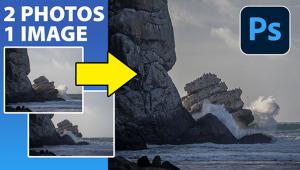Pro Gear: Today It’s More Than Cameras, Lenses, And Lights
When the term pro gear is used these days it means more than a high-priced camera
and fast lens, or a strobe setup that can fire three heads at once and still
have juice to spare. Pros these days also have to be concerned with fast computers,
terabytes of backup, and large-screen monitors that display images in all their
glory. They also need the software to run it all, and the knowledge to get the
most from every pixel. One of the consequences of the "digital revolution"
is that pros now have to be concerned with more than capturing a great image--they
now have to be able to process that image and in some cases make it ready for
press. They might even have to create a web page for marketing and a site that
clients can view to select images for everything from a wedding album to an
ad campaign.
 Yes, it all begins with the image, and the talent and ability to translate a
moment into a memory, or to massage a product so that it appeals to someone
flipping through the pages of a magazine, or to make a portrait so good that
someone will want it on their wall. But now that we have instant worldwide communication,
and an infrastructure that allows an image to go around the world moments after
it is captured, the gear and skills required can become quite complex. Lenses,
cameras, and lights are still important elements in a pro's kit, but how
the image is handled after the exposure has become as essential to success as
how it was originally made.
Yes, it all begins with the image, and the talent and ability to translate a
moment into a memory, or to massage a product so that it appeals to someone
flipping through the pages of a magazine, or to make a portrait so good that
someone will want it on their wall. But now that we have instant worldwide communication,
and an infrastructure that allows an image to go around the world moments after
it is captured, the gear and skills required can become quite complex. Lenses,
cameras, and lights are still important elements in a pro's kit, but how
the image is handled after the exposure has become as essential to success as
how it was originally made.
The learning curve in all this can be intimidating, to say the least. Perhaps the best teacher of all this is experience, peer learning, and getting a handle on all the aspects of what it means to be a professional in this day and age. There are few photographers I know of who are immune from all this. Some can afford assistants to handle all these matters, but many have to tackle these tasks themselves. And that's when talents such as web design, image backup and retrieval, and color management come into play, hardly the kind of things most folks consider when the inspiration to become a pro photographer first strikes them.
This is not to say you can't be a pro (which, by definition, happens when you apply your talent and abilities to help pay the rent) without these digital skills. But in your road toward your dream don't forget that photography has undergone a major change in the last few years, and that vision and talent behind the camera, while laudable, is not all it takes. You can take all the images you like these days and work with the most expensive gear you can afford. But you also have to get the pictures out there to be seen by current and prospective clients alike. And you also have to be able to put your hands on a specific image whenever you, or the buyer, wants. Those are the skills that many photographers need in these days when an image is information, and communication is the form of distribution in which most sales are made.
Part of our task here at Shutterbug is to provide you with the tools and techniques for these matters, and to hopefully spark your creative side by showing the work of, and discussing the "workflow" of, a diverse selection of photographers. You can also attend workshops and seminars to get more knowledge. But the key ingredient is time and dedication to your craft. One way to do this is to create a project for yourself, and to work through all the aspects of capture, edit, organization, and delivery to prints or the web. Just doing it will teach you where you need to fill in the gaps, just as taking on a shooting assignment will help you decide the cameras, lenses, and lighting equipment you might need to get the best images you can.

 Yes, it all begins with the image, and the talent and ability to translate a
moment into a memory, or to massage a product so that it appeals to someone
flipping through the pages of a magazine, or to make a portrait so good that
someone will want it on their wall. But now that we have instant worldwide communication,
and an infrastructure that allows an image to go around the world moments after
it is captured, the gear and skills required can become quite complex. Lenses,
cameras, and lights are still important elements in a pro's kit, but how
the image is handled after the exposure has become as essential to success as
how it was originally made.
Yes, it all begins with the image, and the talent and ability to translate a
moment into a memory, or to massage a product so that it appeals to someone
flipping through the pages of a magazine, or to make a portrait so good that
someone will want it on their wall. But now that we have instant worldwide communication,
and an infrastructure that allows an image to go around the world moments after
it is captured, the gear and skills required can become quite complex. Lenses,
cameras, and lights are still important elements in a pro's kit, but how
the image is handled after the exposure has become as essential to success as
how it was originally made.The learning curve in all this can be intimidating, to say the least. Perhaps the best teacher of all this is experience, peer learning, and getting a handle on all the aspects of what it means to be a professional in this day and age. There are few photographers I know of who are immune from all this. Some can afford assistants to handle all these matters, but many have to tackle these tasks themselves. And that's when talents such as web design, image backup and retrieval, and color management come into play, hardly the kind of things most folks consider when the inspiration to become a pro photographer first strikes them.
This is not to say you can't be a pro (which, by definition, happens when you apply your talent and abilities to help pay the rent) without these digital skills. But in your road toward your dream don't forget that photography has undergone a major change in the last few years, and that vision and talent behind the camera, while laudable, is not all it takes. You can take all the images you like these days and work with the most expensive gear you can afford. But you also have to get the pictures out there to be seen by current and prospective clients alike. And you also have to be able to put your hands on a specific image whenever you, or the buyer, wants. Those are the skills that many photographers need in these days when an image is information, and communication is the form of distribution in which most sales are made.
Part of our task here at Shutterbug is to provide you with the tools and techniques for these matters, and to hopefully spark your creative side by showing the work of, and discussing the "workflow" of, a diverse selection of photographers. You can also attend workshops and seminars to get more knowledge. But the key ingredient is time and dedication to your craft. One way to do this is to create a project for yourself, and to work through all the aspects of capture, edit, organization, and delivery to prints or the web. Just doing it will teach you where you need to fill in the gaps, just as taking on a shooting assignment will help you decide the cameras, lenses, and lighting equipment you might need to get the best images you can.


































